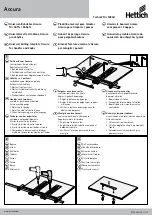
MN-745
12
MAINTENANCE GUIDELINES
By following the steps below, vehicle owners will obtain the longest life and best results
from their air springs.
1. Check the air pressure weekly.
2. Always maintain normal ride height. Never inflate beyond 100 PSI.
3. If you develop an air leak in the system, use a soapy water solution (1/5 liquid dish
soap and 4/5 water) to check all air line connections and the inflation valve core before
deflating and removing the air spring.
FOR YOUR SAFETY AND TO PREVENT POSSIBLE DAMAGE TO YOUR VEHICLE, DO
NOT ExCEED MAxIMUM GROSS VEHICLE WEIGHT RATING (GVWR), AS INDICATED
BY THE VEHICLE MANUFACTURER. ALTHOUGH YOUR AIR SPRINGS ARE RATED AT
A MAxIMUM INFLATION PRESSURE OF 100 P.S.I., THE AIR PRESSURE ACTUALLY
NEEDED IS DEPENDENT ON YOUR LOAD AND GVWR.
4. Loaded vehicles require at least 25 PSI or more. A “loaded vehicle” refers to a vehicle
with a heavy bed load, a trailer, or both. As discussed above, never exceed GVWR,
regardless of air spring, air pressure, or other load assist. The springs in this kit will
support approximately 40 lbs. of load (combined on both springs) for each 1 PSI of
pressure. The required air pressure will vary depending on the state of the original
suspension. Operating the vehicle below the minimum air spring pressure will void the
Air Lift warranty.
5. When increasing load, always adjust the air pressure to maintain the normal ride height.
Increase or decrease pressure from the system as necessary to attain normal ride height
for optimal ride and handling. Remember that loads carried behind the axle (including
tongue loads) require more leveling force (pressure) than those carried directly over the
axle.
6. Always add air to springs in small quantities, checking the pressure frequently.
7. Should it become necessary to raise the vehicle by the frame, make sure the system is at
minimum pressure (5 PSI) to reduce the tension on the suspension/brake components.
Use of on board leveling systems do not require deflation or disconnection.
8. Periodically check the air spring system fasteners for tightness. Also, check the air springs
for any signs of rubbing. Realign if necessary.
9. On occasion, give the air springs a hard spray with a garden hose in order to remove
mud, sand, gravel or other abrasive debris.
TROUBLESHOOTING GUIDE
1. Leak test the air line connections, the threaded connection into the air spring, and all fittings
in the control system.
2. Inspect the air lines to be sure none are pinched. Tie straps may be too tight. Loosen or
replace the strap and replace leaking components.
3. Inspect the air line for holes and cracks. Replace as needed.
4. Look for a kink or fold in the air line. Reroute as needed.
If the preceding steps do not solve the problem, it is possibly caused by a failed air spring — either
a factory defect or an operating problem. Please call Air Lift at (800) 248-0892 for assistance.
FREQUENTLY ASKED QUESTIONS
Q. Will installing air springs increase the weight ratings of a vehicle?
No. Adding air springs will not change the weight ratings (GAWR, GCWR and/or GVWR)
of a vehicle. Exceeding the GVWR is dangerous and voids the Air Lift warranty.
NOTE
CAUTION
RideControl






































